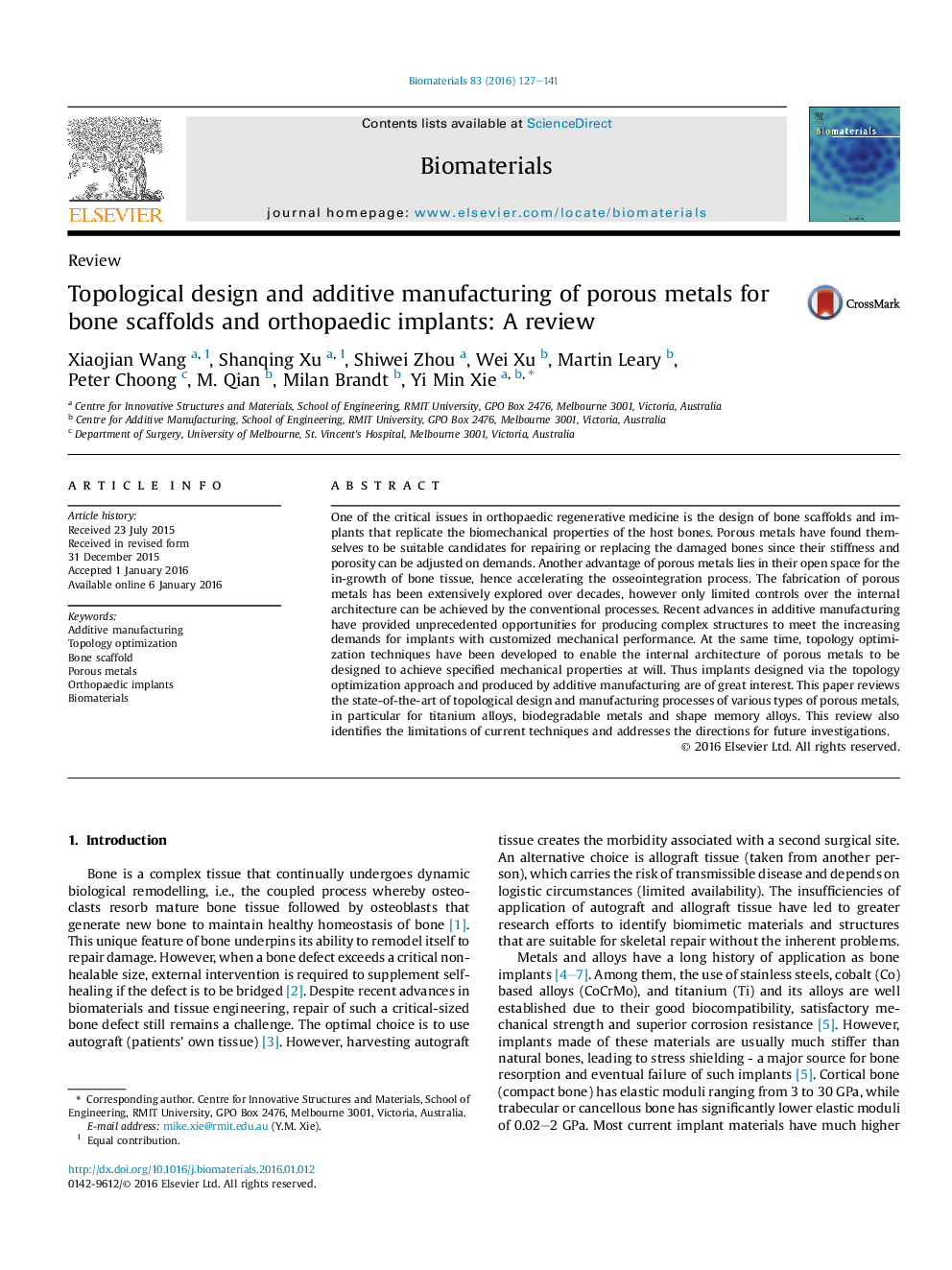| کد مقاله | کد نشریه | سال انتشار | مقاله انگلیسی | نسخه تمام متن |
|---|---|---|---|---|
| 6485119 | 387 | 2016 | 15 صفحه PDF | دانلود رایگان |
عنوان انگلیسی مقاله ISI
Topological design and additive manufacturing of porous metals for bone scaffolds and orthopaedic implants: A review
ترجمه فارسی عنوان
طراحی توپولوژیکی و تولید افزودنی فلزات متخلخل برای داربست استخوان و ایمپلنت ارتوپدی: یک بررسی
دانلود مقاله + سفارش ترجمه
دانلود مقاله ISI انگلیسی
رایگان برای ایرانیان
کلمات کلیدی
تولید افزودنی، بهینه سازی توپولوژی، داربست استخوان، فلزات متخلخل، ایمپلنت ارتوپدی، بیومارکرهای،
ترجمه چکیده
یکی از مسائل حیاتی در پزشکی احیا کننده ارتوپدی، طراحی داربست های استخوان و ایمپلنت هایی است که خواص بیومکانیک استخوان های میزبان را تکثیر می دهند. فلزات متخلخل خود را به عنوان کاندید مناسب برای ترمیم یا جایگزینی استخوان های آسیب دیده یافتند، زیرا سختی و تخلخل آنها می تواند بر تقاضاها تنظیم شود. یکی دیگر از مزایای فلزات متخلخل در فضای باز خود برای رشد در بافت استخوانی است و از این رو تسریع روند استخوانی است. ساخت فلزات متخلخل طی دهه ها به طور گسترده مورد بررسی قرار گرفته است، با این وجود محدودیت های کنترل معماری داخلی توسط فرایندهای متعارف به دست می آید. پیشرفت های اخیر در تولید افزودنی فرصت های بی سابقه ای برای ساخت سازه های پیچیده برای رفع نیازهای روزافزون ایمپلنت با عملکرد مکانیکی سفارشی ایجاد کرده است. در عین حال، تکنیک های بهینه سازی توپولوژی برای ساختن معماری داخلی فلزات متخلخل طراحی شده اند تا بتوانند به خواسته های مکانیزه مشخص شده در حقیقت طراحی شوند. بنابراین ایمپلنت های طراحی شده از طریق رویکرد بهینه سازی توپولوژی و تولید شده توسط تولید افزودنی ها از اهمیت زیادی برخوردار است. این مقاله وضعیت پیشرفته طراحی و پردازش توپولوژیکی انواع مختلف فلزات متخلخل، به ویژه برای آلیاژهای تیتانیوم، فلزات قابل تجزیه پذیر و آلیاژهای حافظه شکل را مورد بررسی قرار می دهد. این بررسی همچنین محدودیت های تکنیک های فعلی را مشخص می کند و دستورالعمل های مربوط به تحقیقات آینده را مورد توجه قرار می دهد.
موضوعات مرتبط
مهندسی و علوم پایه
مهندسی شیمی
بیو مهندسی (مهندسی زیستی)
چکیده انگلیسی
One of the critical issues in orthopaedic regenerative medicine is the design of bone scaffolds and implants that replicate the biomechanical properties of the host bones. Porous metals have found themselves to be suitable candidates for repairing or replacing the damaged bones since their stiffness and porosity can be adjusted on demands. Another advantage of porous metals lies in their open space for the in-growth of bone tissue, hence accelerating the osseointegration process. The fabrication of porous metals has been extensively explored over decades, however only limited controls over the internal architecture can be achieved by the conventional processes. Recent advances in additive manufacturing have provided unprecedented opportunities for producing complex structures to meet the increasing demands for implants with customized mechanical performance. At the same time, topology optimization techniques have been developed to enable the internal architecture of porous metals to be designed to achieve specified mechanical properties at will. Thus implants designed via the topology optimization approach and produced by additive manufacturing are of great interest. This paper reviews the state-of-the-art of topological design and manufacturing processes of various types of porous metals, in particular for titanium alloys, biodegradable metals and shape memory alloys. This review also identifies the limitations of current techniques and addresses the directions for future investigations.
ناشر
Database: Elsevier - ScienceDirect (ساینس دایرکت)
Journal: Biomaterials - Volume 83, March 2016, Pages 127-141
Journal: Biomaterials - Volume 83, March 2016, Pages 127-141
نویسندگان
Xiaojian Wang, Shanqing Xu, Shiwei Zhou, Wei Xu, Martin Leary, Peter Choong, M. Qian, Milan Brandt, Yi Min Xie,
